
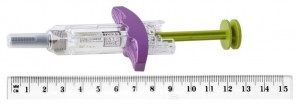
BOMYNTRA 120 mg SOLUTION FOR INJECTION IN PRE-FILLED SYRINGE


How to use BOMYNTRA 120 mg SOLUTION FOR INJECTION IN PRE-FILLED SYRINGE
Introduction
Package Leaflet: Information for the Patient
Bomyntra 120 mg solution for injection in pre-filled syringe
denosumab
This medicinal product is subject to additional monitoring, which will allow for the quick identification of new safety information. You can help by reporting any side effects you may get. The last section of this leaflet includes information on how to report side effects.
Read all of this leaflet carefully before you start using this medicine, because it contains important information for you.
- Keep this leaflet, you may need to read it again.
- If you have any further questions, ask your doctor, pharmacist, or nurse.
- This medicine has been prescribed for you only. Do not pass it on to others. It may harm them, even if their signs of illness are the same as yours.
- If you get any side effects, talk to your doctor, pharmacist, or nurse. This includes any possible side effects not listed in this leaflet. See section 4.
- Your doctor will provide you with a patient reminder card, which contains important safety information that you should know before and during your treatment with Bomyntra.
Contents of the pack
- What is Bomyntra and what is it used for
- What you need to know before you use Bomyntra
- How to use Bomyntra
- Possible side effects
- Storage of Bomyntra
- Contents of the pack and other information
1. What is Bomyntra and what is it used for
Bomyntra contains denosumab, a protein (monoclonal antibody) that slows down bone destruction that occurs when cancer spreads to the bones (bone metastases) or due to giant cell tumor of bone.
Bomyntra is used in adults with advanced cancer to prevent serious complications caused by bone metastases (e.g., fractures, spinal cord compression, or the need for radiotherapy or surgery).
Bomyntra is also used for the treatment of giant cell tumor of bone, which cannot be treated with surgery or when surgery is not the best option, in adults and adolescents whose bones have stopped growing.
2. What you need to know before you use Bomyntra
Do not use Bomyntra
- if you are allergic to denosumab or any of the other ingredients of this medicine (listed in section 6).
- if you have very low levels of calcium in your blood that have not been treated.
- if you have open wounds in your mouth or jaw, due to dental procedures or oral surgery.
Warnings and precautions
Consult your doctor before starting treatment with Bomyntra.
Calcium and vitamin D supplements
You should take calcium and vitamin D supplements during treatment with Bomyntra unless you have high levels of calcium in your blood. Your doctor will explain this to you. If your blood calcium levels are low, your doctor may decide to prescribe calcium supplements before starting treatment with Bomyntra.
Low blood calcium levels
Contact your doctor immediately if you experience muscle spasms, twitches, or cramps, and/or numbness or tingling in your fingers and toes or around your mouth, and/or seizures, confusion, or loss of consciousness during treatment with Bomyntra. You may have low blood calcium levels.
Kidney problems
Tell your doctor if you have or have had severe kidney problems, kidney failure, or if you have needed dialysis, as this may increase the risk of low blood calcium levels, especially if you do not take calcium supplements.
Mouth, tooth, and jaw problems
A side effect called osteonecrosis of the jaw (damage to the jawbone) has been reported in patients receiving injectable Bomyntra for cancer-related conditions. Osteonecrosis of the jaw can also occur after stopping treatment.
It is essential to try to prevent the development of osteonecrosis of the jaw, as it can be a painful condition that can be difficult to treat. To reduce the risk of developing osteonecrosis of the jaw, you should take some precautions:
- Before treatment, tell your doctor or nurse (healthcare professional) if you have any problems with your mouth or teeth. Your doctor should delay the start of your treatment if you have open wounds in your mouth due to dental procedures or oral surgery. Your doctor will recommend a dental examination before starting treatment with Bomyntra.
- While being treated, you should maintain good oral hygiene and have regular dental check-ups. If you wear dental prostheses, you should ensure they fit properly.
- If you are undergoing dental treatment or are going to have dental surgery (e.g., tooth extractions), inform your doctor about your dental treatment and inform your dentist that you are being treated with Bomyntra.
- Contact your doctor and dentist immediately if you experience any problems with your mouth or teeth, such as loose teeth, pain, or swelling, ulcers that do not heal or are suppurating, as these could be signs of osteonecrosis of the jaw.
Patients undergoing chemotherapy and/or radiotherapy, taking steroids or anti-angiogenic medications (used to treat cancer), undergoing dental surgery, not having regular dental check-ups, having gum disease, or being smokers may have a higher risk of developing osteonecrosis of the jaw.
Unusual fractures of the thigh bone
Some people have developed unusual fractures of the thigh bone during treatment with Bomyntra. Contact your doctor if you experience recent or unusual pain in the hip, groin, or thigh.
High blood calcium levels after stopping treatment with Bomyntra
Some patients with giant cell tumors of bone have developed high blood calcium levels weeks or months after stopping treatment. Your doctor will monitor you for signs and symptoms of high blood calcium levels after stopping treatment with Bomyntra.
Children and adolescents
Bomyntra is not recommended for children and adolescents under 18 years of age, except for adolescents with giant cell tumor of bone whose bones have stopped growing. The use of Bomyntra has not been studied in children and adolescents with other types of cancer that have spread to the bones.
Other medicines and Bomyntra
Tell your doctor or pharmacist if you are taking, have recently taken, or might take any other medicines. This includes medicines obtained without a prescription. It is very important that you inform your doctor if you are being treated with
- another medicine that contains denosumab
- a bisphosphonate
You should not take Bomyntra with other medicines that contain denosumab or bisphosphonates.
Pregnancy and breastfeeding
Bomyntra has not been tested in pregnant women. It is essential that you inform your doctor if you are pregnant, think you may be pregnant, or plan to become pregnant. Bomyntra should not be used during pregnancy. Women of childbearing age should use effective contraceptive methods during treatment with Bomyntra and for at least 5 months after stopping treatment with Bomyntra.
If you become pregnant during treatment with Bomyntra or less than 5 months after stopping treatment with Bomyntra, please inform your doctor.
It is not known if Bomyntra is excreted in breast milk. It is essential that you inform your doctor if you are breastfeeding or plan to breastfeed. Your doctor will help you decide whether to stop breastfeeding or stop taking Bomyntra, considering the benefits of breastfeeding for the baby and the benefits of Bomyntra for the mother.
If you are breastfeeding during treatment with Bomyntra, please inform your doctor. Consult your doctor or pharmacist before taking any other medicine.
Driving and using machines
Bomyntra has no or negligible influence on the ability to drive and use machines.
Bomyntra contains sorbitol
This medicine contains 78 mg of sorbitol in each pre-filled syringe.
Bomyntra contains sodium
This medicine contains less than 1 mmol of sodium (23 mg) per 120 mg dose; this is essentially “sodium-free”.
Bomyntra contains polysorbate 20
This medicine contains 0.17 mg of polysorbate 20 in each pre-filled syringe, equivalent to 0.1 mg/ml. Polysorbates may cause allergic reactions. Inform your doctor if you have any known allergies.
3. How to use Bomyntra
For instructions on how to inject Bomyntra, read the last section of this leaflet.
The recommended dose of Bomyntra is 120 mg administered once every 4 weeks in a single injection under the skin (subcutaneously). You can inject the pre-filled syringe of Bomyntra into your thigh or abdomen (except within 5 cm of the navel). A healthcare professional should supervise the first self-injection with the pre-filled syringe of Bomyntra. If someone else administers the injection, Bomyntra can be injected into the thigh, abdomen, or the outer aspect of the upper arm. You or your caregiver should receive training on injection techniques from a healthcare professional. If you are being treated for giant cell tumor of bone, you will receive an additional dose 1 and 2 weeks after the first dose.
Do not shake.
You should also take calcium and vitamin D supplements during treatment with Bomyntra unless you have high levels of calcium in your blood. Your doctor will explain this to you.
If you have any further questions on the use of this medicine, ask your doctor, pharmacist, or nurse.
4. Possible side effects
Like all medicines, this medicine can cause side effects, although not everybody gets them.
Tell your doctor immediatelyif you get any of these symptoms during treatment with Bomyntra:
- muscle spasms, twitches, cramps, numbness or tingling in your fingers and toes or around your mouth, and/or seizures, confusion, or loss of consciousness. These symptoms may be a sign that your blood calcium levels are low. Low blood calcium levels can also cause a change in heart rhythm called QT prolongation, which can be seen on an electrocardiogram (ECG).
Tell your doctor and dentist immediatelyif you get any of these symptoms during treatment with Bomyntra or after stopping treatment:
- persistent pain in your mouth and/or jaw, swelling and/or ulcers that do not heal in your mouth or jaw, suppuration, numbness or a feeling of heaviness in the jaw or loosening of a tooth may be signs of jawbone damage (osteonecrosis).
Very common side effects(may affect more than 1 in 10 people):
- bone, joint, and/or muscle pain that can be severe,
- breathing difficulties,
- diarrhea.
Common side effects(may affect up to 1 in 10 people):
- low phosphate levels in the blood (hypophosphatemia),
- tooth extraction,
- excessive sweating,
- in patients with advanced cancer: development of another type of cancer.
Uncommon side effects(may affect up to 1 in 100 people):
- high blood calcium levels (hypercalcemia) after stopping treatment in patients with giant cell tumor of bone,
- recent or unusual pain in the hip, groin, or thigh (may be an early sign of a possible fracture of the thigh bone),
- skin rash or mouth ulcers (drug-induced lichenoid eruptions).
Rare side effects(may affect up to 1 in 1,000 people):
- allergic reactions (e.g., wheezing or difficulty breathing; swelling of the face, lips, tongue, throat, or other parts of the body; skin rash, itching, or hives). In rare cases, allergic reactions can be severe.
Frequency not known(cannot be estimated from the available data):
- consult your doctor if you have ear pain, discharge from the ear, and/or an ear infection. These could be symptoms of damage to the bones of the ear.
Reporting of side effects
If you experience any side effects, talk to your doctor, pharmacist, or nurse, even if it is possible that they are not listed in this leaflet. You can also report side effects directly through the national reporting system listed in Appendix V. By reporting side effects, you can help provide more information on the safety of this medicine.
5. Storage of Bomyntra
Keep this medicine out of the sight and reach of children.
Do not use this medicine after the expiry date which is stated on the carton and on the label after “EXP”. The expiry date refers to the last day of the month shown.
Store in a refrigerator (2°C - 8°C).
Do not freeze.
Keep the pre-filled syringe in the outer carton to protect it from light.
Before injection, the pre-filled syringe can be left outside the refrigerator to reach room temperature (up to 25°C). This will make the injection less painful. Once the pre-filled syringe has reached room temperature (up to 25°C), it must be used within 30 days.
Medicines should not be disposed of via wastewater or household waste. Ask your pharmacist how to dispose of medicines no longer required. These measures will help protect the environment.
6. Container Contents and Additional Information
Bomyntra Composition
- The active ingredient is denosumab. Each pre-filled syringe contains 120 mg of denosumab in 1.7 ml of solution (which is equivalent to 70 mg/ml).
- The other components are acetic acid, sodium acetate trihydrate, sorbitol (E420), polysorbate 20 (E432), and water for injectable preparations.
Product Appearance and Container Contents
Bomyntra is an injectable solution.
Bomyntra is a clear, colorless to slightly yellowish solution without visible particles.
Each container contains one, three, or four single-use pre-filled syringes.
Only some pack sizes may be marketed.
Marketing Authorization Holder
Fresenius Kabi Deutschland GmbH
Else-Kroener-Strasse 1
61352 Bad Homburg von der Hoehe
Germany
Manufacturer
Fresenius Kabi Austria GmbH
Hafnerstrasse 36
8055 Graz
Austria
Date of Last Revision of this Leaflet
Detailed information on this medicinal product is available on the European Medicines Agency website: http://www.ema.europa.eu/
- Instructions for Use
Component Guide:
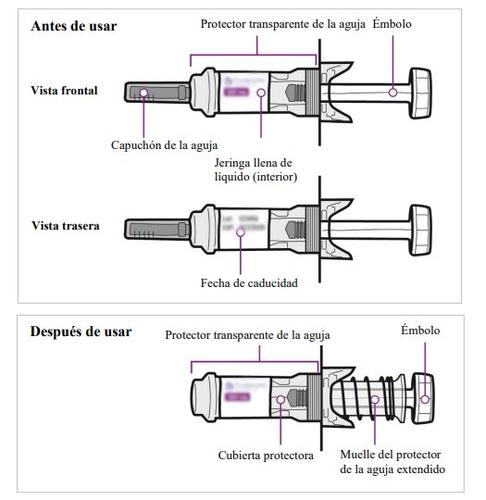
Read this important information before using the Bomyntra pre-filled syringe with automatic needle guard:
- It is important that you do not attempt to administer the injection yourself unless you have been trained by your doctor or healthcare professional.
- Bomyntra is administered by subcutaneous injection into the tissue just under the skin.
- Do notremove the gray needle cap from the pre-filled syringe until you are ready for injection.
- Do notuse the pre-filled syringe if the outer packaging is damaged or the seal is broken.
- Do notuse the pre-filled syringe if it has been dropped onto a hard surface. Use a new pre-filled syringe and contact your doctor or healthcare professional.
- Do notattempt to push the plunger rod of the pre-filled syringe before injection.
- Do notshake the pre-filled syringe.
- Important: Keep the pre-filled syringe out of sight and reach of children.
Storage of the Bomyntra Pre-filled Syringe
- Store Bomyntra in the refrigerator between 2 °C and 8 °C in the original packaging. Do notfreeze.
- Before injection, allow Bomyntra to reach room temperature up to 25°C in the original packaging. This may take between 15 and 30 minutes. Do notheat Bomyntra in any other way.
- Once Bomyntra has been removed from the refrigerator, it must be used within 30 days. If it is not used within 30 days, Bomyntra must be discarded.
- Do not useBomyntra after the expiration date stated on the label.
- You must protect Bomyntra from direct light and heat.
If you have any doubts, contact your doctor or healthcare professional.
Step 1: Preparation of Materials
- Gather Materials
On a clean and well-lit work surface, gather the materials you need for your injection (see Figure A):
. alcohol wipes
. cotton balls or pads
. an adhesive bandage
. a sharps disposal container (see Step 4: Dispose of Your Pre-filled Syringe)
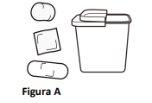
1.2 Wait for 15 to 30 minutes until the pre-filled syringe reaches room temperature
Remove the container from the refrigerator (see Figure B)and place it on a flat surface.

Let the container sit at room temperature for 15 to 30 minutes (see Figure C)
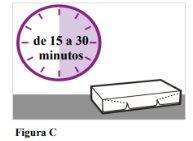
Do notattempt to heat the pre-filled syringe using a heat source such as hot water or a microwave.
Do notleave the pre-filled syringe exposed to direct sunlight.
Do notshake the pre-filled syringe.
Keep the pre-filled syringe out of sight and reach of children.
- Wash Your Hands
Wash your hands with soap and water and dry them with a clean towel (see Figure D).
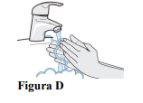
- Remove the Pre-filled Syringe from the Tray
Place two fingers, one on each side, in the center of the transparent needle shield. Pull the pre-filled syringe up and out of the tray (see Figure E).
Do notgrab it by the plunger.
Do notgrab it by the needle cap.
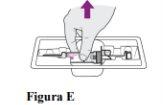
- Examine the Pre-filled Syringe and Medication
Examine the pre-filled syringe to ensure:
- The name on the label is Bomyntra (see Figure F).
- The expiration date on the label has not passed.
- The pre-filled syringe is not cracked or broken.
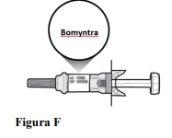
Check the liquid for particles or discoloration (see Figure G).
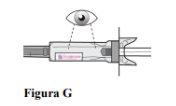
Do notuse the pre-filled syringe if:
- The name on the label is not Bomyntra.
- The expiration date on the label has passed.
- Any of the components are cracked or broken.
- The needle cap is missing or loose.
- The medication is cloudy or contains particles. It should be a clear, colorless to slightly yellowish solution.
In all these cases, use a new pre-filled syringe and contact your doctor or healthcare professional.
Step 2: Prepare for Injection
2.1. Choose an Injection Site
You can inject the medication into (see Figure H):
- the top of the thighs
- the abdomen, except for an area of 5 cm around the navel
- the outer aspect of the upper arm (only if the injection is administered by another person)
Do notinject the medication into areas where the skin is sensitive, bruised, red, or hardened.
Avoid injecting into areas with scars or stretch marks.
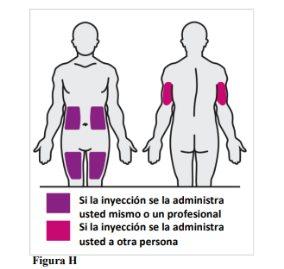
2.2. Clean the Injection Site
Clean the injection site with an alcohol swab (see Figure I).
Let the skin air dry.
Do notblow or touch the injection site after cleaning.
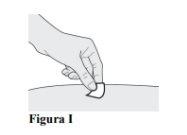
2.3. Remove the Needle Cap
Carefully pull the needle cap straight off and away from your body (see Figure J). You may need to use some force to remove the needle cap.
Do notremove the needle cap from the pre-filled syringe until you are ready for injection.
Do nothold the pre-filled syringe by the plunger.
Do nottwist or bend the needle cap.
Discard the needle cap in your sharps disposal container (see Step 4: Dispose of Your Pre-filled Syringe).
Do notput the needle cap back on the pre-filled syringe.
Do nottouch the needle or let it touch any surface after removing the needle cap.
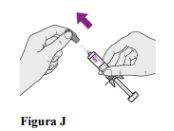
Step 3: Inject the Medication
3.1. Pinch the Skin
Pinch the injection site to create a firm surface (see Figure K).
Note: It is important to keep the skin pinched when injecting.

3.2. Insert the Needle
Insert the needle quickly and directly into the pinched skin at an angle of 45 to 90 degrees (see Figure L).
Do notinject into the muscle or blood vessels.
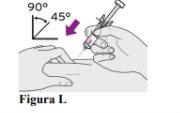
3.3. Inject
Push the plunger with slow and constant pressure (see Figure M)until it can no longer be pushed and all the liquid has been injected under the skin (subcutaneously) (see Figure N). You may hear or feel a "click".
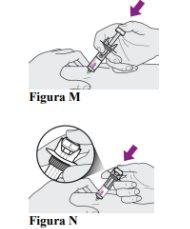
Do notlift the pre-filled syringe off the skin.
3.4. Stop Pressing the Plunger
Stop pressing the plunger slowly and let the needle come out of the skin at the same angle it was inserted. The transparent needle shield will cover the needle safely (see Figure O).
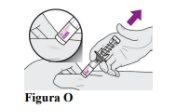
Do notput the needle cap back on used pre-filled syringes.
3.5. Treat the Injection Site
If there is blood or liquid at the injection site, gently press the injection site with a cotton ball or swab (see Figure P).
If necessary, apply a bandage.
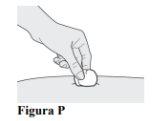
Do notrub the injection site.
Step 4: Dispose of Your Pre-filled Syringe
4.1. Dispose
Dispose of your used pre-filled syringe and needle cap in a sharps disposal container immediately after use (see Figure Q).
Medicines should be disposed of in accordance with local regulations. Ask your pharmacist how to dispose of medicines that are no longer needed. This will help protect the environment.
Do notreuse the pre-filled syringe.
Do notthrow away (dispose of) used syringes in your household trash.
Do notreuse your sharps disposal container.
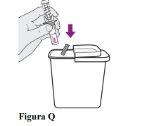
Keep Bomyntra pre-filled syringes, the sharps disposal container, and all medicines out of sight and reach of children.
- Country of registration
- Active substance
- Prescription requiredYes
- Manufacturer
- CompositionACETATO DE SODIO TRIHIDRATO (1,78 mg/ml mg), SORBITOL (47 mg/ml mg), POLISORBATO 20 (0,10 mg/ml mg)
- This information is for reference only and does not constitute medical advice. Always consult a licensed doctor before taking any medication. Oladoctor is not responsible for medical decisions based on this content.
- Alternatives to BOMYNTRA 120 mg SOLUTION FOR INJECTION IN PRE-FILLED SYRINGEDosage form: INJECTABLE, 120 mgActive substance: denosumabManufacturer: Fresenius Kabi Deutschland GmbhPrescription requiredDosage form: INJECTABLE, 60 mgActive substance: denosumabManufacturer: Fresenius Kabi Deutschland GmbhPrescription requiredDosage form: INJECTABLE, 60 mgActive substance: denosumabManufacturer: Mabxience Research S.L.Prescription required




